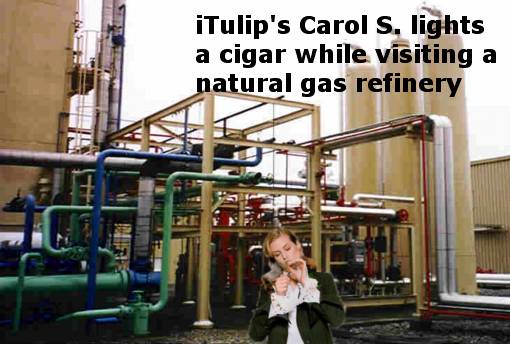 |
On my way back to Boston from NYC, while standing beside my fast, gas guzzling, politically incorrect Infiniti FX, I filled the tank with Premium. For the first time I watch This Sale tick past $70. That was last week. This week filling the tank will cost more than $75. Across the nation, consumers are filling their tanks and thinking, Wow! Of course, the difference between this spike in gasoline prices and the one that hammered the economy in the 1970s is that the banking system hadn't figured out yet how to expand credit to fill the gap in loss of purchasing power of wage income. So far, expanding credit allows consumers to keep the tank filled for the Summer vacation.
Gas made not only a nominal high but reached an inflation-adjusted (real) peak price as well.
Retail Gasoline Prices Set New Record
May 22, 2007 (Stan Choe - AP)
Gasoline Prices at the Pump Set New Record at $3.20 Per Gallon, Crude Futures Jump
Retail gasoline prices climbed to another record Monday, while crude oil futures jumped above $66 per barrel amid concerns about gasoline supply heading into the peak summer driving season.
Cost-push inflation has been in the pipeline for so long that central banks will, sooner or later, have to do something about it. The "something" that they eventually do is certain to have unintended consequences, as it always does as both inflation and debt peak at the top of a credit cycle.May 22, 2007 (Stan Choe - AP)
Gasoline Prices at the Pump Set New Record at $3.20 Per Gallon, Crude Futures Jump
Retail gasoline prices climbed to another record Monday, while crude oil futures jumped above $66 per barrel amid concerns about gasoline supply heading into the peak summer driving season.
The S&P 500 made a nominal high but remains shy of its real peak. Of course, the news is not reported that way, leaving our European and Asian visitors to wonder if Americans are even aware of how uninteresting the US markets look from overseas.
Stocks Mixed After Record S&P 500 Close
May 22, 2007 (Madlen Read - AP)
Stocks Finish Mixed After Lifting S&P 500 Past Closing High for First Time Since 2000
Wall Street reached another milestone during a muted session Monday, when the Standard & Poor's 500 index briefly passed its record close of 1,527.46 for the first time in more than seven years.
But priced in euros, the S&P 500 hit a peak of 974 euros in 2000 and trades around 780 euros now. May 22, 2007 (Madlen Read - AP)
Stocks Finish Mixed After Lifting S&P 500 Past Closing High for First Time Since 2000
Wall Street reached another milestone during a muted session Monday, when the Standard & Poor's 500 index briefly passed its record close of 1,527.46 for the first time in more than seven years.

Meanwhile, REITs, which have remained levitated by sheer investor willpower in the face of continued decline in housing prices, have finally started to reflect the reality of many years of price declines to go.
Stocks Can't Fall? Check Out REITs' Retreat
May 21, 2007 (Doug Kass, Street.com)
Back in early February, the real estate investment trust sector was the cat's meow -- it could do no wrong. Despite my pooh-poohing the sector's seemingly ridiculous popularity (and valuations) on Street Insight and even in a Barron's editorial, the group marched ever higher. Premiums to net asset value were at all-time record highs, dividend yields were at all-time lows (seemingly disconnected from the level of interest rates), multiples to funds from operations hit historically high levels -- and the entire sector was seen as takeover fodder.
[snip]
I will never forget a glib Wall Street conference call at the height of the REIT industry's popularity in January (the firm is not being disclosed to protect the innocent!) in which the senior REIT industry analyst said the IYR could easily tack on another $10 to the upside (from the $92-$93 level) based just on the recycling of capital from the cash-out of the Equity Office Properties capital. Oops!
The similarities between the former popularity and momentum in REIT shares -- which has seemingly evaporated overnight -- could (and should) provide a lesson to investors in the (broader) equity market today. The conditions are eerily similar: the ready (and glib) acceptance of a new investment paradigm, massive liquidity, a bubble in credit availability and terms, a plethora of merger deals and the feeding frenzy of share price momentum -- all are contributing to a REIT-like orgy.
Everyone has their own "it's a top" story lately, such as this story sent to us by a reader.May 21, 2007 (Doug Kass, Street.com)
Back in early February, the real estate investment trust sector was the cat's meow -- it could do no wrong. Despite my pooh-poohing the sector's seemingly ridiculous popularity (and valuations) on Street Insight and even in a Barron's editorial, the group marched ever higher. Premiums to net asset value were at all-time record highs, dividend yields were at all-time lows (seemingly disconnected from the level of interest rates), multiples to funds from operations hit historically high levels -- and the entire sector was seen as takeover fodder.
[snip]
I will never forget a glib Wall Street conference call at the height of the REIT industry's popularity in January (the firm is not being disclosed to protect the innocent!) in which the senior REIT industry analyst said the IYR could easily tack on another $10 to the upside (from the $92-$93 level) based just on the recycling of capital from the cash-out of the Equity Office Properties capital. Oops!
The similarities between the former popularity and momentum in REIT shares -- which has seemingly evaporated overnight -- could (and should) provide a lesson to investors in the (broader) equity market today. The conditions are eerily similar: the ready (and glib) acceptance of a new investment paradigm, massive liquidity, a bubble in credit availability and terms, a plethora of merger deals and the feeding frenzy of share price momentum -- all are contributing to a REIT-like orgy.
 |
May 22, 2007 (Robert Peston - BBC)
It is the totemic deal of our age: the Chinese government is buying 9.9% of Blackstone, the leading US buyout firm, for $3bn (£1.5bn).
The creator of the global financial boom, China, has formed a partnership with one of the great manifestations and beneficiaries of that boom.
But it’s also quite an unnerving event. China’s desire to enjoy the private-equity spoils that its behaviour has created may signal the peak of this phase of global financial mania.
The Chinese government is trading low return dollar denominated US treasury and agency securities for higher return dollar denominated equity securities. Note that common denominator: dollars. Fewer government issued bonars, more of Wall Street's Wally Bucks. Hats off to Henry Paulson for keeping the money in dollars. Who says making China safe for Goldman Sachs isn't good for the country?It is the totemic deal of our age: the Chinese government is buying 9.9% of Blackstone, the leading US buyout firm, for $3bn (£1.5bn).
The creator of the global financial boom, China, has formed a partnership with one of the great manifestations and beneficiaries of that boom.
But it’s also quite an unnerving event. China’s desire to enjoy the private-equity spoils that its behaviour has created may signal the peak of this phase of global financial mania.
Peston is right about the deal indicating a mania peak, but misses the boat on the prediction that mis-priced risk will end it. Peston continues:
And there would come a moment when the price of these riskier assets would be ludicrously high by comparison with the price of a low-risk, US government bond – and at that moment, the bubble would be pricked.
Bubbles are not pricked by increased prices, they are simply made larger. The circumstance that the writer refers to will simply add more fuel to the as-yet unlit fire. The fire will be lit by accident, as iTulip's Carol S. demonstrates. (Not really. She's perfectly safe, unlike the speculators, er, we mean the "investors" in the global speculative bubble.) After it starts, the Fed and global central banks have promised to put it out, no matter how big the fire gets. We shall see. Got a call from a Dow Jones reporter today asking, "Ok, when?" The answer is that we don't know when, or who, or what will ignite the fire. But one fact is certain. The 1990s stock market bubble created $5 trillion in fictitious capital that burned when the stock market went up starting in April 2000. Today the amount of fictitious capital created by Bubbles in Everything is several times that, so the economy will experience several times the negative wealth effect of the 1990s stock bubble after it vanished.
How much, exactly? $20 trillion? $30 trillion? We're working up some estimates. Stay tuned.
iTulip Select: The investment thesis for the Next Cycle™
__________________________________________________
For a book that explains iTulip concepts in simple terms see americasbubbleeconomy
For macro-economic and geopolitical currency ETF advisory services see Crooks on Currencies
For macro-economic and geopolitical currency options advisory services see Crooks Currency Options
For the safest, lowest cost way to buy and trade gold, see The Bullionvault
To receive the iTulip Newsletter or iTulip Alerts, Join our FREE Email Mailing List
Copyright © iTulip, Inc. 1998 - 2007 All Rights Reserved
All information provided "as is" for informational purposes only, not intended for trading purposes or advice. Nothing appearing on this website should be considered a recommendation to buy or to sell any security or related financial instrument. iTulip, Inc. is not liable for any informational errors, incompleteness, or delays, or for any actions taken in reliance on information contained herein. Full Disclaimer
Comment